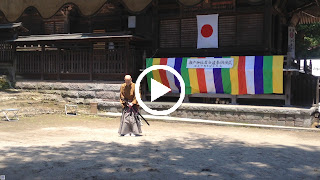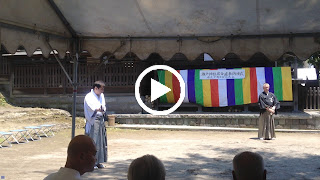Takada Gakudô Sensei
Musô Shinden Ryû 20th Sei Seiden
Takada Gakudô[1]–sensei (iaidô hanshi 10 dan) is the head of the Yûshingijuku Takada Dôjô and the 20th headmaster of our Musô Shinden ryû[2] Gotô-ha[3] -line. He came to Europe for the first time in 1986 to teach at an iaidô seminar in Uppsala, Sweden, and has since then been teaching annually at Musô Shinden ryû seminars in the Nordic and Baltic countries.
Takada Shigeru was born on June 19th, 1939, in Yokohama, where he still lives with his family. In budô circles he is known by the name Gakudo. His father's name was Takada Noriyuki[4], and he has five older siblings: four brothers and one sister. Takada-sensei went to school first at the Nishimae primary school[5] and then at the Nishi middle school[6] completing his studies at a business school[7] and university[8]. After this he was employed by a private company[9] in Yokohama until his retirement in 1992.
Takada-sensei's budô career will be discussed later in this article. Takada-sensei balances his budô activities with a wide range of other interests:
· calligraphy (shodô)[10], tea ceremony (sadô - Higashi Abe ryû senchadô)[11], traditional Japanese singing (shigin - Nihon kokufû ryû)[12], shôgi[13]-game (nidan amateur rank). Takada-sensei has played shôgi for twenty years from the age of 20. Gô[14]-game (sandan amateur rank). Sensei started to play gô at the age of 40, and still plays from time to time.
Takada-sensei thinks there are both physical and spiritual aspects to iaidô, and cultural/mental activities help one's spiritual being grow. "If you concentrate on the physical side only, stillness remains foreign to you". To be able to grow as an iaidôka, one must seek balance. Sensei is a member in e.g. the Nihon Shôgi Renmei and the Nihon Igô Renmei.
Takada-sensei's Family
Mrs. Takada, Rumi[15]-sensei, too, is very well versed in iaidô. She is at the moment iaidô hanshi 8 dan, Keishichô ryû[16] iaidô 5 dan and jôdô[17] 4 dan. She gives piano lessons and plays contrabass every now and then (when she was younger, she used to play this instrument in the string section of an orchestra). Like Takada-sensei, she sings, but instead of shigin she specializes in buddhist goeika[18]‑ ja shunkyôka[19]‑hymns. She does also ikebana (koryû)[20].
Takada- and Rumi-sensei's son Shigenori[21] is iaidô renshi 7 dan, Keishichô ryû iaidô 3 dan and jôdô 4 dan. His professional name in the world of budô is Tokudô[22], and in "civilian" life he works for a Japanese company operating in the communications sector. Tokudô-sensei is married to Katja (iaidô 1 dan), who began practicing iaidô in Helsinki. Their son Isami[23] was born in 2010. Daughter Megumi[24] (iaidô 1 dan) is not active in iaidô at the moment. She works in the health care sector. Her husband's name is Yamada Yukio[25].
Takada-sensei's Early Budô Years
Takada-sensei came into contact with iaidô in 1954 at the Dai Nippon Teikoku Shinkenkan Matsuo Kenpu Dôjô , which he had joined in the previous year. In the beginning he just wanted to improve his kendô. Matsuo Kenpu-sensei put a sword in his hands and that was that: Takada-sensei has been on the iaidô path ever since.
At the outset he was training three times per week, but later there came a time when he had time to train just once a week. At first they concentrated on the basics, which were taught through kata, in addition to which Sensei trained with a 4-kilo tanrenbô[26]. He was using a shinken from the very beginning, but as a beginner he did not do tameshigiri ("not enough skill" says Takada-sensei).
Sensei says his skills increased steadily, without any dramatic leaps. He paraphrases Lao Tzu: "a thousand mile journey is made one step at a time[27]". One never reaches the end of the road, there is always a new stretch ahead.
Sensei does not remember any one thing that he found difficult in the beginning. Rather, there are challenges everywhere, if one takes training seriously ̶ especially, when life's urgencies leave little time for training. Iaidô is an art that affects both one's mind and body and is therefore ideal for physical and mental training. Practicing with a Nihon-tô[28], a Japanese sword made ceremonially by a traditional swordsmith, serves as a bridge to the traditional bujutsu culture.
A Summary of Takada-sensei's Budô Career
- iaidô 4 dan, 1959
- iaidô 5 dan, 1960
- iaidô 6 dan, 1962
- iaidô renshi, 1962
- iaidô 7 dan
- iaidô kyôshi, 1975
- iaidô 8 dan, 1986
- iaidô hanshi, 1996
- iaidô 9 dan, 2001
- iaidô10 dan, 2004
- Musô Shinden Ryû iai 8 dan menkyo kaiden, 1975
Takada-sensei's Budô Arts
As a member of the Matsuo Dôjô Takada-sensei was expected to study even other budô arts in the manner of his sensei. Thus he is familiar with the following arts, all of which he studied at Matsuo Kenpu-sensei's Shinkenkan Dôjô.
- Kendô (kyôshi 7 dan, ZNKR)
- Jûkendô (kyôshi 6 dan, ZNJR)
- Tankendô (5 dan, ZNJR)
- Ono-ha Hôki ryû iai (menkyo kaiden, 2nd sôke)
- Mugai ryû iai (menkyo kaiden)
- Keishichô ryû iaidô (seishihan)
- Hôzoin ryû sôjutsu (kyôshi 8 dan)
- Shindô Musô ryû jôdô (kyôshi 7 dan)
- Yagyû ryû tessenjutsu (kyôshi 6 dan)
- Yagyû ryû kusarigamajutsu (kyôshi 6 dan)
- Araki ryû nagamakijutsu (kyôshi 7 dan)
- Araki ryû chikirigijutsu
- Araki ryû iai
- Kuroda ryû shurikenjutsu
- Aikidô
- Jujutsu
Due to lack of time Takada-sensei focuses now solely on iaidô and jôdô.
Takada-sensei's Own Dôjô
Takada-sensei founded his own dôjô in 1974 because he wanted to implement his own ideas about budô. The dôjô was at first called Taigijuku Takada Dôjô[29], but Sensei later renamed it Yûshingijuku Takada Dôjô[30], because he wanted to incorporate the names of Nakayama Hakudo-sensei's Yûshinkan[31] and Matsuo Kenpu-sensei's Shinkenkan[32] dôjô in the honor of his teacher and his teacher's teacher.
Present Day
Takada-sensei is now retired from the business world and concentrates on his responsibilities in the world of budô. He is kept very busy, for he is at the moment:
- President of Nippon Iaidô Kyôkai[33]
- Musô Shinden Ryû Gotô-ha 20. sei seiden
- Yushingijuku Takada Dôjô juku-chô
- Dai Nippon Teigoku Shinkenkan Matsuo Kenpu Dôjô shihan-dai
- Ono-ha Hôki Ryû iaihyôhô sei seiden.
In addition to these responsibilities he teaches iaidô and jôdô at his dôjôs located in the Yokohama area:
- Oppama Junior High School (Oppama, Yokosuka)
- Nakada Junior High School (Totsuka, Yokohama)
- Kanazawa Chikusentaa (Kanazawahakkei, Yokohama) (though at the time of the interview the Chiku Center was being renovated and no lessons were given there).
The curriculum consists of Musô Shinden Ryû iaidô and Nippon Iaidô Kyôkai Tôhô lessons given to all students. In addition, Sensei teaches Musô Shinden Ryûn ryûgi style and other iai styles (Keishichô Ryû, Mugai Ryû ja Hôki Ryû) to his more advanced students. Besides iai, Sensei gives lessons even in Shindô Musô Ryû jôdô.
Sensei visits annually Musô Shinden Ryû organizations abroad: in Sweden, Finland and Estonia. In the future these visits will be extended even to Southern Europe, as there is a new Musô Shinden Ryû Gotô-ha club in Bulgaria's capital Sofia.
Takada-sensei's dôjô participates annually in various iaidô demonstrations in Japan, e.g. in the Nippon Iaidô Kyôkai Taikai at the Iseyama Kôtai temple in Yokohama and demonstrations at Tsurugaoga Hanchimangû shrine in Kamakura and Setô shrine in Kanazawahakkei, Yokohama.
Sensei's Answers to Miscellaneous Questions about Iaidô
1. When Nakayama Hakudô -sensei created our style, Ômori Ryû and Hasegawa Eishin Ryû were taught as independent iai schools. His students later incorporated them under the names "Shoden" and "Chûden" into our style, which was at first known as Musô Shinden Eishin Ryû[34] (among other names). The style was given the name Musô Shinden Ryû at about Showa 40 = v. 1965) after Nakayama-sensei died.
2. Characteristics of a Good Iaidô Teacher:
- skilled
- correct basics
- fluent, big movements
- brisk nukitsuke and kirioroshi
- able to do fast technique
- a person of understanding, even in matters outside the world of the sword.
3. Grading tests are used to check the technical and spiritual development of the student. A dan grade measures one's iai skill, a mokuroku is a reflection of how the individual has assimilated the essence of the school.
Takada-sensei's Thoughts about Iaidô
Iaidô can be said to be zen with a sword in your belt. It is a path of continuous study, where techniques are used to train both the body and the mind. The objective is to realize a better world in accordance with divine commandments. A spiritual path is sought through the medium of iai forms, which is why it is important that the forms one is taught are practiced faithfully. One must be loyal to the teaching one is given and genuinely strive to assimilate it.
Practitioners of iaidô have varied personal motives for training. For an enduring effort on this path one needs passion, conviction, patience and self-control. Training may be painful at times, but one must be patient and conquer oneself[35]. Then there is nothing one cannot achieve.
The following applies not only to iai, but to life in general. The most important thing is to conquer oneself. When one learns this, one can achieve anything. Takada-sensei learnt this very early, because Matsuo Kenpu-sensei used to quote Takeda Shingen[36] (1521-1573): "If one is truly willing to do something, one is always successful in it. If one tries and does not succeed, it is because one was not really fully committed from the outset."[37] This is something everyone should ponder upon ̶ especially us students of iaidô, because this is a road of solitary struggle.
Yokohama 2010-01-30 (The news about Takada-sensei's grandson's birth were added later)
[2] Musô Shinden Ryû
夢想神伝流 [5] Nishimae shôgakkô
西前小学校 [7] Dai-ichi shôgyo kôtô gakkô
第一商業高等学校 [11] sadô - Higash Abe ryû senchadô
茶道(
東阿部流 煎茶道)
[12] shigin - Nihon kokufû ryû
詩吟 (
日本国風流 師範)
[16] Keishichô Ryû Iaidô
警視庁流居合道 [20] kadô (koryû)
花道 (
古流)
[21] Takada Shigenori
高田茂徳 [27]senri no michi mo hitoashi zutsu
千里の道も一足ずつ [29] Taigijuku Takada Dôjô
大義塾高田道場 [30] Yûshingijuku Takada Dôjô
有心義塾高田道場 [33] Nippon Iaidô Kyôkai
日本居合道協会 [34] Musô Shinden Eishin Ryû
夢想神傳英信 [37] naseba naru nasaneba naranu nanigoto mo
naranu wa hito no nasanu narikeri
「為せばなる、為さねばならぬ何事も、
ならぬは己が為さぬなりけり」









-1.jpg)
-1.jpg)
-1.jpg)
-1.jpg)
-1.jpg)
-1.jpg)
-1.jpg)




